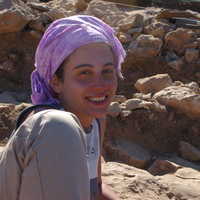- Archaeometallurgy, Archaeological Science, Aegean Archaeology, Greek Archaeology, Aegean Prehistory (Archaeology), Ceramic Analysis (Archaeology), and 9 moreArchaeometry, Survey (Archaeological Method & Theory), Early Bronze Age, Copper extraction and production, Ancient Iron Metallurgy, Islamic Archaeology, Arabian/Persian Gulf Archaeology, Ancient Glass, and Pyrotechnologyedit
Buddhist wall paintings from a cave complex in Saspol, Ladakh, India, dating to the 14-15th century, were taken up for a study of their painting technology. Paint micro-samples were investigated by scanning electron and optical... more
Buddhist wall paintings from a cave complex in Saspol, Ladakh, India, dating to the 14-15th century, were taken up for a study of their painting technology. Paint micro-samples were investigated by scanning electron and optical microscopy, and multi-spectral imaging of the paintings conducted at site. Azurite, vermilion, orpiment, indigo, and madder are the main inorganic and organic pigments identified. Pigments were typically applied in one or more layers on the wall surfaces, depending on the painting scheme and on the colour finish desired. The materials and techniques employed for the Saspol paintings are consistent with those known to exist in the region up to that time, with no indications of any new external influences as made out for their artistic style or iconographic content.
Research Interests:
Research Interests:
Research Interests:
Research Interests:
Murwab is one of the most important early Islamic archaeological villages in the Arabian Peninsula and the Persian Gulf, and one of the best-known. Excavated since the 1950s, the site has yielded a complete pottery assemblage which allows... more
Murwab is one of the most important early Islamic archaeological villages in the Arabian Peninsula and the Persian Gulf, and
one of the best-known. Excavated since the 1950s, the site has yielded a complete pottery assemblage which allows the site to be
dated from the late eighth to the late ninth century AD.
This paper presents an analysis of the ceramics of Murwab. The analysis is undertaken on a selection of 134 pottery sherds
of common ware/‘kitchen’ ware without glaze and encompasses a petrographic study and elemental analysis using wavelength
dispersive X-ray fluorescence spectrometry (WDXRF). The results of the petrographic analysis and some preliminary thoughts
on the chemical analysis are discussed in the text. Twelve ceramic fabrics have been detected in the assemblage studied. The
composition of the fabrics allows some preliminary suggestions about provenance to be drawn: none of the fabrics was locally
made in Qatar and most of them seem to come from Mesopotamia, eastern Arabia, and southern Iran.
The technology of the ceramics reveals an approach to the manufacture of common wares that is characteristic of the Upper
and Central Gulf (corresponding roughly to the Gulf coast west of the Musandam Peninsula, including Khuzestan and Bushehr in
Iran). It is not known when this technological approach started, but it does not seem to be documented in the Bronze Age.
one of the best-known. Excavated since the 1950s, the site has yielded a complete pottery assemblage which allows the site to be
dated from the late eighth to the late ninth century AD.
This paper presents an analysis of the ceramics of Murwab. The analysis is undertaken on a selection of 134 pottery sherds
of common ware/‘kitchen’ ware without glaze and encompasses a petrographic study and elemental analysis using wavelength
dispersive X-ray fluorescence spectrometry (WDXRF). The results of the petrographic analysis and some preliminary thoughts
on the chemical analysis are discussed in the text. Twelve ceramic fabrics have been detected in the assemblage studied. The
composition of the fabrics allows some preliminary suggestions about provenance to be drawn: none of the fabrics was locally
made in Qatar and most of them seem to come from Mesopotamia, eastern Arabia, and southern Iran.
The technology of the ceramics reveals an approach to the manufacture of common wares that is characteristic of the Upper
and Central Gulf (corresponding roughly to the Gulf coast west of the Musandam Peninsula, including Khuzestan and Bushehr in
Iran). It is not known when this technological approach started, but it does not seem to be documented in the Bronze Age.
Research Interests:
Ceramic production and distribution analyses are not frequent for the Almohad rural society in al-Andalus and completely absent in the Balearic Islands. Here, we discuss the role of Islamic ceramics at the seaside site of Puig de Sa... more
Ceramic production and distribution analyses are not frequent for the Almohad rural society in al-Andalus and completely absent in the Balearic Islands. Here, we discuss the role of Islamic ceramics at the seaside site of Puig de Sa Morisca (southwestern Mallorca) applying archaeometric techniques such as petrographic microscope and X-ray fluorescence spectrometry. The results evidenced a dominance of a chemically monogenic group characterised by Neogene calcareous marine clays. Furthermore, some ceramics seem to have been produced in the urban centre of Madīna Mayūrqa and later distributed to the neighbouring rural area. On the other hand, a reduced number of pieces were identified as imported items similarly distributed in rural contexts. These materials indicated that significant social and economic interaction networks between urban and rural communities were at work before the Christian conquest of the island.
